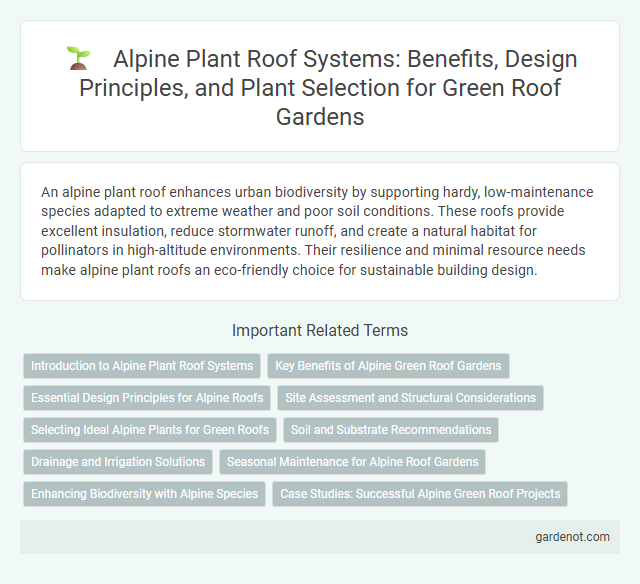An alpine plant roof enhances urban biodiversity by supporting hardy, low-maintenance species adapted to extreme weather and poor soil conditions. These roofs provide excellent insulation, reduce stormwater runoff, and create a natural habitat for pollinators in high-altitude environments. Their resilience and minimal resource needs make alpine plant roofs an eco-friendly choice for sustainable building design.
Introduction to Alpine Plant Roof Systems
Alpine plant roof systems utilize hardy, low-growing vegetation adapted to high-altitude environments, providing excellent drought tolerance and insulation benefits. These systems reduce stormwater runoff, improve air quality, and enhance urban biodiversity by supporting specialized pollinators and wildlife. Implementing alpine plants on green roofs promotes sustainable urban development through resilient, low-maintenance landscaping solutions.
Key Benefits of Alpine Green Roof Gardens
Alpine green roof gardens enhance urban biodiversity by supporting specialized, hardy plant species adapted to extreme mountain conditions, which improve ecosystem stability. These roofs provide superior insulation, reducing building energy consumption and mitigating urban heat island effects. Their efficient water retention capacity minimizes stormwater runoff, lowering flood risks while promoting sustainable water management.
Essential Design Principles for Alpine Roofs
Alpine plant roofs require well-drained, shallow soils with high mineral content to mimic natural mountain habitats and prevent root rot. Selecting hardy, drought-resistant alpine species such as Sedum, Sempervivum, and Saxifraga ensures plant survival under extreme temperature fluctuations and intense sunlight exposure. Incorporating proper slope and substrate depth optimizes water runoff and retention, maintaining a balanced microenvironment essential for alpine vegetation growth.
Site Assessment and Structural Considerations
Alpine plant roofs require thorough site assessment to evaluate factors such as sunlight exposure, wind conditions, and microclimate, ensuring optimal plant survival and growth. Structural considerations include verifying load-bearing capacity to support the additional weight of soil, vegetation, and retained water, along with adequate drainage and root barrier systems to prevent damage to the building. Proper evaluation helps in selecting suitable alpine species that thrive under specific environmental stresses while maintaining building integrity.
Selecting Ideal Alpine Plants for Green Roofs
Choosing ideal alpine plants for green roofs involves prioritizing species like Sedum, Saxifraga, and Sempervivum known for their drought tolerance and shallow root systems. These plants thrive in well-drained substrates with minimal soil depth, providing excellent erosion control and thermal insulation. Their adaptability to harsh rooftop conditions, including wind exposure and temperature fluctuations, ensures long-term survival and sustainable green roofing.
Soil and Substrate Recommendations
Alpine plant roofs require lightweight, well-draining substrates that mimic natural mountain soil conditions, typically composed of a mix of sand, fine gravel, and organic matter to ensure optimal root aeration and moisture retention. A substrate depth of 8 to 12 cm is recommended to support the shallow root systems of alpine species while maintaining structural load limits. pH levels should be slightly acidic to neutral (5.5 to 7.0) to promote nutrient availability and healthy plant growth in alpine green roof environments.
Drainage and Irrigation Solutions
Alpine plant roofs require specialized drainage systems to prevent waterlogging while maintaining optimal moisture levels for drought-tolerant species. Engineered layers incorporating rapid drainage mats and water retention substrates balance efficient water runoff with essential hydration. Integrated irrigation solutions use sensor-controlled drip systems tailored to alpine flora's minimal water needs, ensuring sustainable growth and ecosystem stability.
Seasonal Maintenance for Alpine Roof Gardens
Seasonal maintenance for alpine plant roofs requires careful attention to drainage and soil health to prevent waterlogging during wet seasons and dehydration in dry periods. Removing dead foliage and trimming back overgrown plants in late spring promotes healthy growth and maximizes sunlight exposure for low-growing alpine species. Ensuring nutrient replenishment with slow-release fertilizers tailored for alpine plants supports resilience against harsh weather conditions throughout the year.
Enhancing Biodiversity with Alpine Species
Alpine plant roofs enhance biodiversity by introducing resilient, native alpine species that thrive in harsh rooftop environments, supporting local pollinators and wildlife. These specialized plants create microhabitats that increase urban ecological diversity and improve ecosystem services. Incorporating alpine species on green roofs boosts plant variety while contributing to sustainable urban landscapes.
Case Studies: Successful Alpine Green Roof Projects
Alpine plant roofs demonstrate exceptional resilience and biodiversity in harsh environments, as seen in successful case studies like the Rocky Mountain Alpine Green Roof and the Swiss Alps Eco-Rooftop. These projects showcase the ability of native alpine species to enhance urban ecosystems by improving insulation, reducing stormwater runoff, and promoting habitat connectivity. Data from these installations confirm increased plant survival rates of over 85% and significant energy savings in adjacent buildings.
Alpine plant roof Infographic

 gardenot.com
gardenot.com